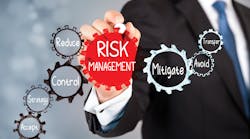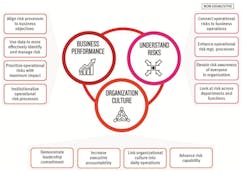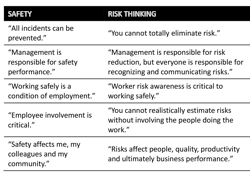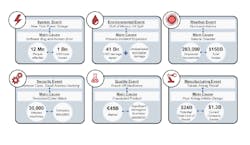Many companies believe that as long as employees follow established procedures, the organization will achieve safe operations and, therefore, business success. Unfortunately, it’s not that simple. Rarely does this way of thinking result in sustainable safety or business performance across an organization.
Instead, companies should focus on risk reduction outcomes, rather than simply completing tasks, to ensure real results. While completing tasks may satisfy required compliance measures, there is no guarantee this will bring the expected benefit to the organization. Effectiveness ought to be assessed by the extent of the resulting risk reduction, not simply by how well standards and procedures are followed.
Also, risk management and safety activities should not be thought of as separate from the company’s business objectives. Choosing safety versus production will result in competing priorities within the organization. Instead, organizations should have “safe production” in mind. Risk reduction and safety initiatives should align with operational strategy, which in turn ought to align with business strategy to generate real value for the business. (see Figure 1)
Figure 1
Achieving risk reduction outcomes that are tied to business strategy can be done by implementing an integrated framework in which four key components—employee mindsets and behaviors; organizational governance and management; processes and technology; and workers’ capabilities and competencies—continuously reinforce each other.
MINDSETS AND BEHAVIORS
Being safe is a “lagging” concept. It is a partial reflection of how well risks are managed. The fact is, effective risk reduction can correlate to strong safety performance, but strong safety performance does not necessarily mean risks are being effectively managed.
To foster proactivity of efforts and continuous improvement, there needs to be a shift in the mindset of employees from safety to risk (see Table 1). While all safety incidents can be prevented, it is not possible to completely eliminate all risks in an operational environment. Therefore, risks need to be continually identified and reduced, or at least kept in check, to ensure safe operations.
Table 1
Also, psychologically the concept of risk is more personal to employees than safety. Workers decide daily whether a risk is acceptable to take, but they often see “safety” as the responsibility of the company. Shifting the mindset of employees to risk-based thinking ensures vigilance and reduces complacency, especially when safety performance has been deemed acceptable.
GOVERNANCE AND MANAGEMENT
Not all risks are equal. As Figure 2 indicates, some risk events are less likely to occur but carry with them impacts that are potentially devastating (e.g., multiple fatalities, prolonged equipment down-time, bankruptcy, etc.). Other risks are more likely, but have impacts that are much less severe (e.g., minor injuries, time-off work, etc.).
Figure 2
Because an organization’s resources are limited, those resources should be applied judiciously to ensure maximum risk reduction. To do this, organizations need to have a clear understanding of their operational risk profile, which is assessed against the common definitions of likelihood and impacts, and prioritize focus and ownership of risks based on a defined tolerance.
When doing so, companies should place sufficient emphasis on risks that can lead to large-scale incidents. In a global survey of executives from 350 companies conducted by DuPont Sustainable Solutions in the fall of 2018, two-thirds of executives acknowledge feeling safe when presented with data showing incident rates are low. This indicates executives seem more concerned with short-term impacts and are often not paying attention to other important indicators of potential long-term significant events.
PROCESSES AND TECHNOLOGY
Managing risks requires system thinking. When conducting investigations of safety incidents, root causes need to be identified at the system level and addressed accordingly to prevent re-occurrence. Failure to identify and address system issues may cause incidents to be repeated in the future.
By extension, to prevent the occurrence of safety incidents, organizations need to manage risks at a system level, recognizing the interconnectivity of the various processes that make up the system. Effective risk management cannot be achieved in silos. Unfortunately, many companies seem to struggle with this. In the same global survey of executives, 44% of executives acknowledge that gaps exist among their existing systems, preventing effective integration.
CAPABILITIES AND COMPETENCIES
Ultimately, any safety management system needs to be executed by people. It will not result in desired outcomes without a workforce that is capable and has the right mindset and discipline to execute it, and without the processes for managing employee performance.
Leveraging the day-to-day operational knowledge of front-line personnel on the shop floor or in the field is a key success factor in any cultural transformation. Organizations should recognize that these personnel are a critical layer of protection within their operations. These workers are most familiar with the organization’s activities, equipment and processes, and therefore the risks. They should be appropriately engaged, empowered and supported.
Finally, it is important that leaders be “affective” in their approach to risk management. Company executives should seek to foster a trusting work environment, and their leadership style should demonstrate humility and partnership with employees. They should encourage bottom-up engagement with employees, not top-down edicts from the C-suite.
Given the day-to-day demands on an organization it is easy to adopt a “check the box” mentality and assume that as long as procedures are being followed, the company is operating safely and productively. All too often, this false sense of security eventually gives way to an incident that sends shockwaves throughout the organization.
By focusing more on risk reduction outcomes and linking risk mitigation activities to the organization’s business strategies, companies can realize improved operations and productivity.



